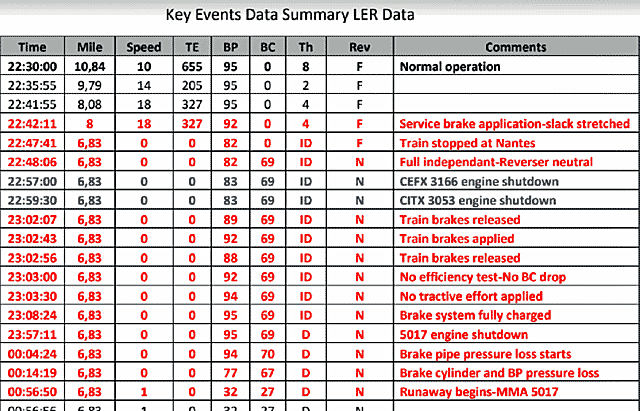
Sherbrooke Quebec - An expert witness in railway accidents told the judge and jury in the Lake Megantic trial none of the ill-fated train's 73 tank cars had handbrakes applied, so once the runaway train broke away from its locomotives, it had with no brakes at all.
Left idling overnight at Nantes on 5 Jul 2013 the train laden with crude oil rolled 12 kilometres down the track into downtown Lake Megantic, where it derailed and exploded, killing 47 people.
Steven Callaghan, who was hired by provincial police to scrutinize the devastation in the aftermath of the rail disaster, is the Crown's 27th witness in the trial underway at the Sherbrooke courthouse.
Deemed an expert witness by the court, Callaghan is the only witness allowed to testify based on his opinion.
Dumas has given strict instructions to all other witnesses to testify only on known facts.
Callaghan pored over a document entered as Crown evidence, in which Francois Daigle, the engineer who drove the notorious locomotive 5017 a day before the tragedy, noted mechanical problems.
He testified that the mechanical breakdown of the ill-fated train's lead locomotive was a problem which "required attention of maintenance people."
He said that in his opinion, the defective locomotive should have been replaced.
Earlier in the trial, the court heard that a fire, which broke out in the smokestack of that locomotive about an hour before the deadly derailment resulted in firefighters shutting down the engine.
That also shut off the air brakes which were securing the train.
Callaghan told the court the mechanical breakdown didn't cause the fire on the locomotive, but he said, "If the locomotive has a mechanical problem even before the fire, you minimize your potential problems by placing it in a position where it will not be the lead locomotive."
No Handbrakes Applied on Tank Cars
Callaghan testified when he arrived in Lake Megantic a week after the tragedy, his first task was to examine the locomotives, the buffer car, and the first 10 cars in the consist.
"I was looking for pre-existing damage if possible, and in this particular case, whether or not the handbrakes had been applied," he said.
Callaghan told the court all five of the locomotives, the VB (a remote-control car that housed equipment needed for a single-crew operation), and the buffer car, had handbrakes applied to them, for a total of seven.
However, he explained, the handbrakes on a locomotive are not as efficient as the handbrakes on a wagon like a tank car.
"They are different, in that they may only apply brakes on one or two of the brake shoes," he said.
Callaghan explained on wagons, handbrakes secure all eight wheels.
He told the court he saw no sign of the handbrakes being applied on any of the tanker cars.
"With the seventh wagon, I couldn't tell because it was too damaged," he said, but added, "with no handbrakes on the first six tank cars, and no handbrakes on eight, nine, ten, the probability there was a handbrake on the seventh is low."
Callaghan testified he inspected other fuel cars for signs the handbrakes had been applied and found no evidence of wheels having been overheated by braking.
When asked by the Crown what that meant, Callaghan answered, "There were no brakes, hand or automatic, applied to the train."
Air Brakes Not Sufficient to Secure Train
Earlier in the trial, the court heard testimony from a railway traffic controller who said it was common practice for MMA employees working in Farnham to leave the lead locomotive running when a train was parked and left unattended.
Last week former MMA employee Steve Jacques testified that leaving the head locomotive running added extra insurance in securing the train, because it allowed the air brakes to stay engaged.
The Crown pressed Callaghan on that issue Tuesday, asking him whether locomotive engineers are supposed to rely on air system brakes to secure a train.
"No," said Callaghan.
"The only sure way to secure the train is to apply a sufficient number of handbrakes to prevent movement."
Brake Efficiency Test Called into Question
Callaghan testified he compiled a seven-page report about the sequence of the accident, based on data he obtained from the train's black box.
He spent several hours Tuesday explaining the meaning of that data and graphics.
Earlier in the trial, the jury heard that a brake efficiency test must be performed by a locomotive engineer once a train is stopped, to make sure it won't move once it's left unattended.
The Crown prosecutor asked Callaghan if he could tell if a brake efficiency test had been performed on the train when it was left at Nantes, based on the data he'd recovered.
"I see a constant independent brake cylinder pressure, and I see that the train air brakes have been released," he responded.
"But the independent brake was never released. And to perform a proper efficiency test, all the air brakes must be released."
"The independent and automatic brakes must be fully released, and the independent was not?" Callaghan was asked.
"That is correct," he responded.
Callaghan is expected to continue his testimony Wednesday.
Author unknown.
under the provisions in
Section 29 of the Canadian
Copyright Modernization Act.



